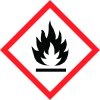M-8015-R-2N-5ML
AccuStandard, Inc
Revision date : 2015-09-21


General Information
Revision date
2015-09-21
Product name
M-8015-R-2N-5ML
Product Synonyms
Diethyl ether
CAS No.
60-29-7
Supplier name
AccuStandard, Inc
Emergency telephone
AccuStandard, Inc
Icons in SDS
Company Information
Company name
AccuStandard, Inc
E-mail address of the competent person responsible for the Safety Data Sheet
edocs@accustandard.com
GHS Information
Signal word
Danger
Hazard Codes
Hazard statements (CLP)
H224, H302, H312, H315, H332
Hazard statements
Code
Statements
H224
Extremely flammable liquid and vapour
H302
Harmful if swallowed
H312
Harmful in contact with skin
H315
Causes skin irritation
H332
Harmful if inhaled
Precautionary statements
Code
Statements
P202
Do not handle until all safety precautions have been read and understood.
P262
Do not get in eyes, on skin, or on clothing.
P264
Wash ... thoroughly after handling.
P280
Wear protective gloves/protective clothing/eye protection/face protection.
P284
[In case of inadequate ventilation] Wear respiratory protection.
P331
Do NOT induce vomiting.
P338
Remove contact lenses, if present and easy to do. Continue rinsing.
P352
Wash with plenty of water/...
P404
Store in a closed container.
Section 2
SECTION 2: Hazards identification
2.2 Label elements
4 * 2 HEALTH 2 1 4 FLAMMABILITY 1 - continued P280 - Protective gloves must be worn to prevent skin contact. P284 - Respiratory Protection: If workplace exposure limit(s) of product or any component is exceeded (see TLV/PEL), a NIOSH/MSHA approved air supplied respirator is advised in absence of proper environmental control.
Signal word
Danger
Hazard statements
H224 - Extremely flammable liquid and vapor. (Flammable liquids, category 1) H224 - Extremely flammable!! (Flammable liquids, category 1) H302 - Harmful if swallowed. (Acute toxicity, oral, category 4) H312 - Harmful if absorbed through skin. (Acute toxicity, dermal, category 4) H315 - Irritating to skin. (Skin corrosion/irritation, category 2) H332 - Harmful if inhaled. (Acute toxicity, inhalation, category 4) Precautionary Codes: P202 - This product should only by used by persons trained in the safe handling of hazardous chemicals. P262 - Do not get in eyes, on skin or clothing. P264 - Wash thoroughly after handling. Do not take internally. Eye wash and safety equipment should be readily available. - continued
2.3 Other hazards
2.2.1 - Symptom of Exposure Health/Environment Extremely flammable!! (Flammable liquids, category 1) Exposure can cause headache, nausea, confusion, drowsiness, dizziness and/or vomiting. Prolonged or repeated contact can result in defatting and drying of the skin which may result in skin irritation or dematitis (rash). Alcohol consumed before or after exposure may increase adverse effects. Teratogenic hazard. Extremely flammable liquid and vapor. (Flammable liquids, category 1)
Potential health effects
May be irritating to eyes. Irritating to skin. (Skin corrosion/irritation, category 2) Harmful if absorbed through skin. (Acute toxicity, dermal, category 4) Readily absorbed through skin. Irritating to mucous membrane and upper respiratory system. (Specific target organ toxicity, single exposure; Respiratory tract irritation, category 3) Harmful if inhaled. (Acute toxicity, inhalation, category 4) Harmful if swallowed. (Acute toxicity, oral, category 4) 2.2.3 - Routes of Entry Inhalation, ingestion or skin contact. 2.2.4 - Carcinogenicity This product is or contains a component that is not listed (ACGIH, IARC, NTP, OSHA) as a cancer causing agent.

